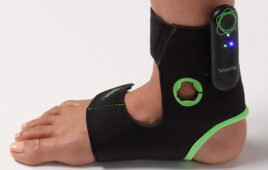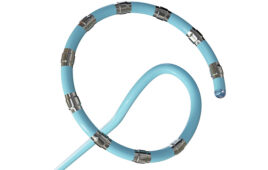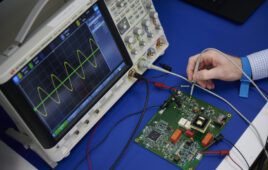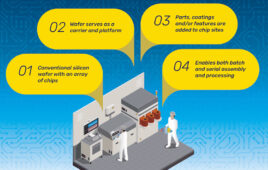Implementing robust electrostatic discharge (ESD) control is critical for enhancing product reliability and ensuring adherence to industry standards.
By Elizabeth Norwood, MicroCare
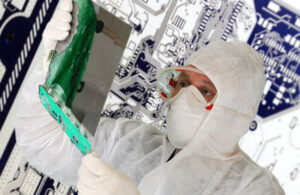
Electrostatic discharge (ESD) is an invisible threat to medical device electronics. [Image courtesy of MicroCare]
These tightly regulated facilities are meticulously designed to maintain ultra-low levels of airborne particles and contaminants but can paradoxically foster the accumulation of static electricity. This poses a significant risk to the delicate electronic components that power vital medical devices like implantable cardiac devices and drug delivery systems.
The mitigation of ESD-related failures significantly affects the reliability of these technologies. It is estimated that up to one-third of all printed circuit board (PCB) failures stem from this unseen phenomenon, underscoring the criticality of proactively tackling the threat of ESD.
Understanding ESD in medical device manufacturing

Manufacturers can reduce failures, improve longevity, and safeguard patient safety by understanding ESD behavior. [Image courtesy of MicroCare]
While invisible to the naked eye, these discharges can wreak havoc on resistors, integrated circuits, microprocessors and other sensitive electronic components found in modern medical devices. The consequences range from catastrophic failures that render the device inoperable immediately to insidious latent damage, which may go undetected initially only to manifest as intermittent malfunctions, reduced performance or premature failure during the product’s lifecycle.
In some critical medical devices, these failures can mean the difference between life and death.
Cleanroom challenges and ESD control
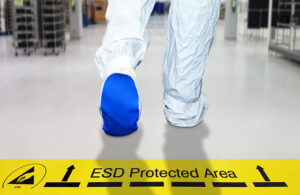
Assembly, repair, cleaning, inspection, and packaging areas are vulnerable to electrostatic discharge events. [Image courtesy of MicroCare]
However, measures taken to uphold cleanroom protocols — such as using specialized gowning materials — can inadvertently contribute to the build-up of static electricity. The presence of human operators is another problem, as people entering and moving about the cleanroom can generate significant ESD through friction and physical movements.
Manufacturing areas where hands-on work occurs, including assembly, repair, cleaning, inspection and packaging, are particularly vulnerable to electrostatic discharge events. Even electrical equipment used for tasks like troubleshooting circuitry can be a source of ESD if not correctly grounded.
Medical device manufacturing machinery and production line components like conveyors and robotic systems can create ESD through friction between their materials as they run. Counterintuitively, fans and other equipment and practices intended for contamination control can induce ESD due to rapid air movements disturbing the electrostatic equilibrium near sensitive devices.
Adding to the challenge, outsourcing medical device production to contract manufacturers in different geographic regions with varying cleanroom standards underscores the need for robust and consistent ESD control measures across the entire supply chain.
Adhering to international standards with multi-layered ESD control

It is estimated that up to one-third of all printed circuit board (PCB) failures stem from ESD. [Image courtesy of MicroCare]
Cleanroom facilities must implement a multi-layered strategy in line with international standards to safeguard critical electronic medical devices from ESD-related failures throughout the production process. This begins with precise environmental controls.
Implementing proper grounding measures for personnel and surfaces is paramount. Operators should be outfitted with anti-static wrist or heel straps that keep them continuously grounded via a hardwired connection when handling PCBs. Conductive floor mats that discharge static build-up are also essential in work zones. All workstations, tables, racks, and equipment where ESD-sensitive operations occur must also be grounded. Anti-static garments, shoe coverings and gloves should be worn to provide a crucial extra layer of protection for technicians.
Tight control over air quality is also key. Maintaining humidity levels between 40-70% and ambient temperatures around 64-70°F (18-22°C) helps prevent static charge accumulation.
Practices that could induce charge imbalances and ESD events must also be avoided. One example is using compressed air to clean or dry PCB assemblies. Unnecessary insulative items like plastic trays, bins and work accessories should be removed.
Implementing strict ESD-safe packaging protocols for receiving, handling and shipping all PCB assemblies and electronic components is important. From anti-static containers to low-charging shipping materials, every step must be taken to mitigate ESD exposure throughout the process.
Controlling static build-up
Nearly everything in and around the PCB production line can accumulate static charges. Even conductive items like electric soldering irons, reflow ovens and wave soldering machines can develop static electricity.
To dissipate these charges, it’s crucial to regularly wipe down all surfaces and tools with pre-saturated, ESD-reducing cleaning wipes. High-quality ESD wipes can remove contaminants like fingerprints, grease and oil without leaving behind lint, debris or static. Wipe in overlapping straight lines to cover all areas thoroughly, ensuring each stroke overlaps the previous one by 10-25%.
When selecting ESD-dissipating wipes, look for options with low alcohol content. While alcohol is an ideal non-conductive workplace cleaner, it can dry out mats, cause fissures or leave surfaces brittle over time.
Utilizing ESD-safe cleaning tools

A cleaning fluid dispensing system helps reduce static charges, protecting microchips, and other sensitive electronic components. [Image courtesy of MicroCare]
Instead of plastic straws, use ESD-safe controlled flux remover dispensing tools made from durable aluminum and stainless steel. These tools incorporate the user into the grounding circuit through direct contact, reducing static charges to just 50 volts and preventing ESD from reaching the PCB, microchips and other sensitive electronic components.
These dispensing systems often include brush and syringe attachments, allowing thorough cleaning under low-profile surface-mounted components. The brush’s scrubbing action increases the cleaning fluid’s effectiveness, loosening and rinsing away contaminants with minimal cleaner usage.
A controlled dispensing system keeps the flux remover clean for each application, delivering the precise amount of fluid needed to wet the PCB without overspray or waste. This approach can reduce fluid consumption, cut costs and make disposal easier as non-hazardous waste.
Quality assurance and compliance
Stringent quality assurance and regulatory compliance are non-negotiable in cleanroom-based medical device manufacturing. Implementing robust ESD control is critical for enhancing product reliability and ensuring adherence to industry standards. Maintaining consistent ESD control across the entire supply chain is essential when outsourcing production. Regular audits, supplier qualifications and continuous improvement of cleanroom ESD protocols mitigate risks and ensure compliance.
Manufacturers can reduce failures, improve longevity and safeguard patient safety by understanding ESD behavior in cleanrooms, adhering to best practices and tailoring multifaceted ESD control strategies.

Elizabeth Norwood [Photo courtesy of MicroCare]
How to submit a contribution to MDO
The opinions expressed in this blog post are the author’s only and do not necessarily reflect those of Medical Design & Outsourcing or its employees.

